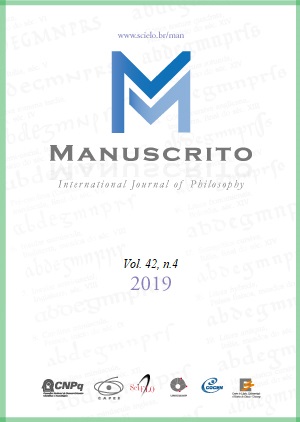Resumen
According to Aristotle, phainomena or “appearances” provide the basis from which researches proceed. This shows that in spite of phainomena often corresponding to what falsely appears to be the case, there is genuine cognition through them. In this paper, I focus on two features of phainomenal cognition: accessibility and epistemological limitation. A phainomenal cognition of x is limited in the sense that there is always a stronger cognition of x to be attained. In this way, a research always aims at surpassing the phainomenal cognition of its subject matter. On the other hand, phainomenal cognition is always somehow accessible. Resorting to the relation between phainomena and the distinction between the more intelligible to us and the more intelligible by nature, I intend to put forward a relative (as opposed to an absolute) understanding of both accessibility and epistemological limitation of phainomena.
Citas
ALLAN, D. J. 1936. Aristotelis - De Caelo. (DC) Oxford: Clarendon.
ANGIONI, L. 2001. “Explanation and Definition in Physics 1.1”. Apeiron, 34, pp. 307-320.
ANGIONI, L. 2010. “Aristóteles e o progresso da investigação científica : o caso do De Caelo”. Scientiae Studia, v. 8, n. 3, pp. 319-338.
ANGIONI, L. 2017. “Explanation and method in the Eudemian Ethics”. Archai, 20, pp. 191-229.
BARNES, J. 1980. “Aristotle and the methods of ethics”. Revue Internationale de Philosophie, 34, pp. 490-511.
BARNES, J. [1975] 1993. Posterior Analytics. 2 ed. Oxford: Clarendon Press.
BEKKER, I. 1831. Peri Zôiôn Moriôn. (PA) Berlin: Reimer.
BOLTON, R. 1991. “Aristotle’s method in natural science: Physics I.” In: L. Judson (ed.), pp. 1-29.
BOLTON, R. 2009. “Two Standards for Inquiry in Aristotle’s De Caelo”. In A. C. Bowen and C. Wildberg (eds.), pp. 51-82.
BONITZ, H. [1870] 1961. Index Aristotelicus. 2. ed. Berlin: Walter de Gruyter.
BOWEN, A. C.; WILDBERG, C. 2009. New Perspectives on Aristotle’s De Caelo. Leiden: Brill.
BYWATER, I. 1894. Aristotelis – Ethica Nicomachea. (NE) Oxford: Clarendon.
CHARLTON, W. [1970] 1992. Aristotle Physics Books I and II. Oxford: Clarendon.
DEVEREUX, D. 2015. “Scientific and ethical methods in Aristotle’s Eudemian and Nicomachean Ethics.” In D. Henry, D and K. M. Nielsen (eds.), pp. 130-147.
DROSSAART LULOFS, H. J. 1965. Aristotelis de generatione animalium. (GA) Oxford: Clarendon.
FALCON, A. 2005. Aristotle and the science of nature. Cambridge, Cambridge U. P.
FESER, E. 2013. Aristotle on Method and Metaphysics. Houndmills, Palgrave Macmillan.
FOBES, F. H. 1919. Aristotelis meteorologicorum libri quattuor. (Meteor.) Cambridge: Harvard U. P.
FREDE, D. 2012. “The endoxon mystique: what endoxa are and what they are not”. Oxford Studies in Ancient Philosophy, vol. 43, pp. 185-215.
HASPER, P. S.; YURDIN, J. 2014. “Between perception and scientific knowledge: Aristotle’s account of experience.” Oxford Studies in Ancient Philosophy, vol. 47, pp. 119-150.
HENRY, D., NIELSEN, K. M. 2015. Bridging the gap between Aristotle’s science and ethics. Cambridge: Cambridge U. P.
INWOOD, B.; WOOLF, R. 2013. Aristotle: Eudemian Ethics. Cambridge U. P.
IRWIN, T. 1987. “Ways to first principles: Aristotle’s methods of discovery”. Philosophical Topics, v. XV, n. 2, pp. 109-134.
IRWIN, T. 1988. Aristotle’s first principles. Oxford: Clarendon.
JOACHIM, H. H. 1926. Aristotle on Coming-to-be and Passing Away. (GC) Oxford: Clarendon.
JUDSON, L. 1991. Aristotle’s Physics: A collection of essays. Oxford, Clarendon.
KARBOWSKI, J. 2015a. “Endoxa, facts, and the starting points of the Nicomachean Ethics”. In D. Henry, D and K. M. Nielsen (eds.), pp. 113-129.
KARBOWSKI, J. 2015b. “Phainomena as Witnesses and Examples: The Methodology of Eudemian Ethics 1.6.” Oxford Studies in Ancient Philosophy 49, pp.193-226.
KONSTAN, D. 1975, “A Note on Aristotle Physics 1.1”. Archiv für Geschichte der Philosophie, n. 57, pp. 241-245.
LESHER, J. 2010. “Saphêneia in Aristotle: ‘Clarity’, ‘Precision’, and ‘Knowledge’. Apeiron, 43 (4) pp. 143- 156.
MANSION, S. 1961. Aristote et les problèmes de méthode. Louvain: Publicacions Universitaires de Louvain.
MANSION, S. 1979. “‘Plus connu en soi’, ‘plus connu pour nous’. Une distinction epistemologique importante chez Aristote.” Pensamiento, v. 35, pp. 161-170.
MCKIRAHAN, R. 1992. Principles and proofs. Princeton: Princeton U. P.
MINIO-PALUELLO, L. 1949. Aristotelis Categoriae et Liber De Interpretatione. (Categ. and De Int.) Oxford: Clarendon Press.
NUSSBAUM, M. 1986. The fragility of goodness. Cambridge: Cambridge U. P.
OWEN, G. E. L. 1961. “Tithenai ta phainomena”. In S. Mansion (ed.), pp. 83-103.
ROSS, W. D. 1908. Aristotle. Metaphysica. Oxford: Clarendon.
ROSS, W. D. 1924. Aristotle’s Metaphysics. (Metaph.) Oxford: Clarendon.
ROSS, W. D. 1936. Aristotle’s Physics. (Phys.) Oxford: Clarendon.
ROSS, W. D. 1949. Aristotle’s Prior and Posterior Analytics (APr and APo) Oxford: Clarendon.
ROSS, W. D. 1955. Aristotle. Parva Naturalia. (PN) Oxford: Clarendon Press, 1955.
ROSS, W. D. 1956. Aristotle. De anima. (DA) Oxford: Clarendon.
ROSS, W. D. 1958. Aristotelis Topica et Sophistici Elenchi. (Top. and Soph. El.) Oxford: Clarendon.
SHIELDS, C. 2013. “The Phainomenological Method in Aristotle’s Metaphysics”. In E. Feser (ed.), pp. 7-27.
SHIELDS, C. 2016. Aristotle. De Anima. Oxford: Oxford University Press.
STOCKS, J. L. 1922. De Caelo. Oxford: Clarendon.
WALZER, R. R.; MINGAY, J. M. 1991. Aristotelis Ethica Eudemia. (EE) Oxford: Clarendon.


